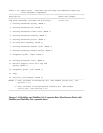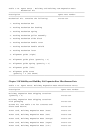
Many electronic components are sensitive to ESD. Circuitry design and
structure determine the degree of sensitivity. The following proper
packaging and ground precautions are necessary to prevent damage.
o To avoid hand contact, transport products in static-safe containers such
as tubes, bags, or boxes.
o Protect all electrostatic parts and assemblies with conductive or
approved containers or packaging.
o Keep electrostatic sensitive parts in their containers until they arrive
at static-free stations.
o Place items on a grounded surface before removing them from their
container.
o Always be properly grounded when touching a sensitive component or
assembly.
o Place reusable electrostatic-sensitive parts from assemblies in
protective packaging or conductive foam.
Use transporters and conveyors made of antistatic belts and roller
bushings. Mechanized equipment used for moving materials must be wired to
ground and proper materials selected to avoid static charging. When
grounding is not possible, use an ionizer to dissipate electric charges.
4.1.3 Preventing Damage to Drives
To prevent static damage to diskette drives and hard drives, use the
following precautions:
o Handle drives gently, using static-guarding techniques.
o Avoid touching the connectors on the hard drive.
o Store drives in the carrying case. Use the Hard Drive Carrying case, not
the MultiBay Device Carrying Case.
o Avoid dropping drives from any height onto any surface.
o Handle drives on surfaces that have at least one inch of shock-proof
foam.
4.1.4 Grounding Methods
The method for grounding must include either a wrist strap or a foot strap
at a grounded workstation. When seated, wear a wrist strap connected to a
grounded system. When standing, use footstraps and a grounded floor mat.
Table 4-2. Static Shielding Protection Levels
===========================================================================


















